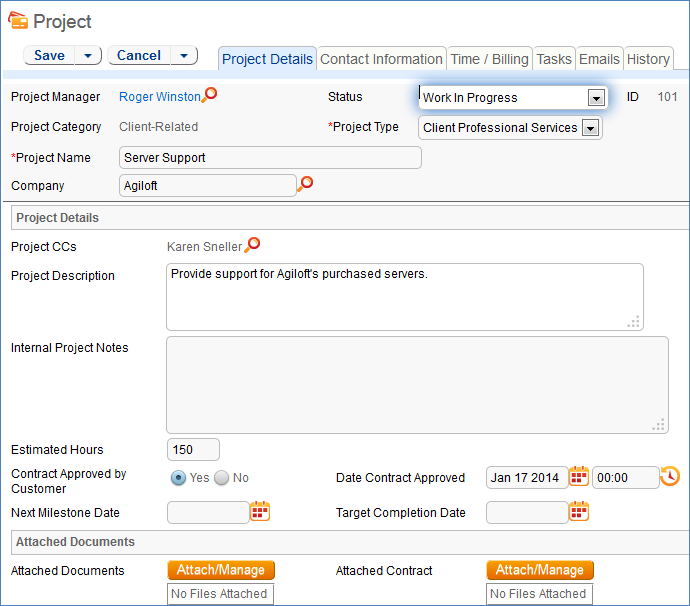Project Management consists of a few tables, some of which are described in this topic.
Projects Table
The Projects table holds records for project management activities. It is currently optimized for companies providing consulting services to their clients, and allows them to manage their billable and unbillable hours, work authorizations, and overall project status. It can easily be customized for internal project management instead.
Use Case
Members of the Admin or Project Manager groups may manually create Project records. Projects are creatable only in the "Planned", "Assigned", "Work in Progress" and "Awaiting Customer Feedback" states.
Only members of the Product Manager and admin Groups may edit others' Project records, but Support Staff (Base ServiceDesk group) may view their own Project records. The user who created the Project is automatically set as the Project Manager, and will get email notifications pertaining to the Project's status, such as when all tasks are completed or the hours spent on the project have exceeded what was authorized. Project CCs can be specified who will also receive notice when the Project is completed. The information on the "Contact Information" tab will be filled out with the information of the Project Manager's Manager, provided by the Employee record of the Project Manager.
Project records are divided into two broad categories: Internal and Client-Related. These categories are further divided by type. The tasks that are automatically generated by a project depend on the type selected. For each Project type there are task templates that list the tasks that get automatically generated. The exact selection of tasks that will be generated can be specified on the "Tasks" tab of the Project record. Ad-hoc tasks can also be created using an action button on that tab. Additional fields are visible when a Project's Category is "Client-Related". These fields hold information about customer contracts, contact details, and authorized hours.

Time spent on the project is tracked on the "Time / Billing" tab. It includes a small form to enter time spent and a related table of time entries for this project. Time entries can be searched for in the related table and linked to the project manually.
Workflow

Ownership
Records in this table are owned by the Employee designated as the Project Manager.
Project Types Table
Project Types is a background table that holds the Project Types referenced by the Projects table. It allows the creation of new Project Types by Project Managers and other users without Admin group privileges. Project Types define the task generation method, if any, and if task workflows will be used, they are defined in the project type record.

In addition to Predefined Task Workflows, project types may use Users Selected Tasks or User Generated Ad Hoc Tasks as the task generation methods.

The differences between these methods is discussed in more detail in the Tasks for Service Requests section above, and the same options available for Service Requests apply to Projects. The methodology for setting up task workflows and the way in which the prerequisite tasks are handled is discussed above in the Task Workflows Table section and in the Task Templates section.
Purchase Orders (PO) Table
The Purchase Order table tracks authorized billable hours for a project. It is shown as a related table within the Project table. It could easily be linked to support cases or Quotes or other tables within the system.
PO records are creatable manually via the web form, from within Project records in the related table, or via mass import. Only members of the Professional Services, Sales and admin Groups may create or import records. PO records are creatable in any workflow state.
Only members of the Professional Services, Sales and admin Groups may edit records, but Support Staff may view all PO records.
Ownership
Records in this table are owned by an Employee, generally the one who created the record. Each record is associated with a particular Employee login.



